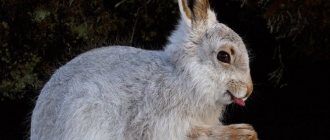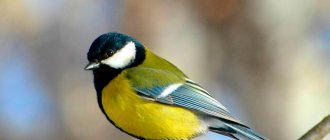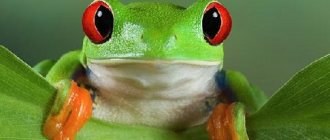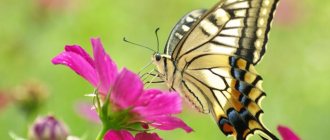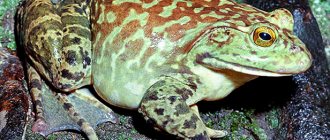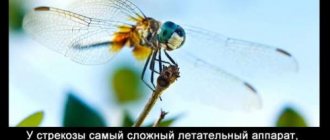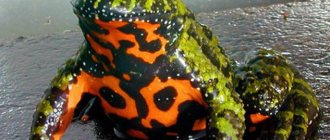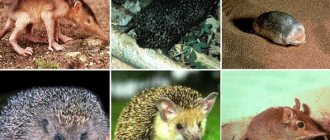- Reports and messages
- Animals
- Frog
Scientists classify frogs as tailless amphibians.
That is, these are animals that can live both in water and on land. In total, there are more than 500 species of frogs. They live everywhere, all over the earth, except the far north. Most of them are found in tropical forests, as it is always damp and warm there. Frogs are divided by habitat. There are arboreal, aquatic and terrestrial. Mermen have webbed feet for swimming. Woody ones have special pads with which they stick well to the tree. Some tree frogs have special webbed feet and folds of skin on the sides that allow them to “fly.” They jump from tree to tree and use these devices to glide. Ground animals have no membranes or pads, and their paws are very developed, since movement on the ground is very difficult. Frogs are good jumpers. Compared to the length of their body, they jump very far and very quickly.
The largest frog is the goliath frog. Its length is 32 centimeters. The smallest is the leaf frog. It is only 2 centimeters in size. But most often the size of these amphibians is from seven to fifteen centimeters. The skin of all frogs is covered with special mucus. It protects the skin from harmful microbes and helps heal wounds. In some species this mucus is poisonous. This is how they protect themselves from their enemies. Most often these are tree frogs that are found in the tropics.
These animals feed on small insects: dragonflies, flies, mosquitoes. Most frogs have a long, sticky tongue, which they use to catch food. The tongue moves very quickly and manages to catch an insect in flight. Large individuals can catch a small snake, grab a chick or another small frog.
The frog reproduces by laying eggs. Tadpoles hatch from the eggs after about 10 days. They are called that because they only have a head and a tail. Gradually, the tadpoles grow and change: their legs grow and their tail disappears. After four months they turn into a frog.
Each species of frog croaks differently. Sometimes these sounds are so loud that they can be heard a kilometer away.
Some frogs are kept as pets and kept in aquariums.
Interesting Facts:
- Our great-grandmothers and great-grandfathers threw frogs into milk and it did not turn sour, since the skin of these animals kills bacteria
- The frog's eyes are located on the sides, and it can see in several directions at once - sideways, up, forward.
- Even during sleep, their eyes do not close, but are covered with a special film - the inner eyelid.
Internal structure
Adult amphibians are predators, feeding on various insects and other invertebrate animals; some aquatic amphibians catch small vertebrates.
Digestive system
The digestive system begins with a large oropharyngeal cavity, at the bottom of which the tongue is attached at the anterior end. When catching prey, the tongue is thrown out of the mouth, and the prey sticks to it. Streams of salivary glands open into the oropharyngeal cavity. Their secretion moistens the cavity and food, making it easier to swallow prey. On the upper jaw there are small conical teeth that serve only to hold prey. Food moistened with saliva enters the esophagus and then into the stomach. The glandular cells of the stomach walls secrete the enzyme pepsin, which is active in an acidic environment (hydrochloric acid is also released in the stomach).
Partially digested food moves to the duodenum, into which the bile duct of the liver flows. Pancreatic secretions also flow into the bile duct. The duodenum quietly passes into the small intestine, where nutrients are absorbed. Undigested food remains enter the wide rectum and are expelled through the cloaca.
Respiratory system
The frog breathes through its lungs and through its skin. On the walls of the paired sac-like lungs there is an extensive network of blood vessels. When the frog opens its nostrils and lowers the bottom of the oropharyngeal cavity, air enters the latter.
Then the nostrils close with valves, the bottom of the oropharyngeal cavity rises, and air passes into the lungs. Exhalation occurs due to the action of the abdominal muscles and the collapse of the pulmonary walls.
Circulatory system
The heart of adult amphibians has three chambers - two atria and one ventricle. An arterial cone with a longitudinal spiral valve inside extends from the ventricle, which distributes arterial and mixed blood into different vessels. The right atrium receives venous blood from internal organs and arterial blood from the skin, i.e. mixed blood gathers here. The left atrium receives arterial blood from the lungs. Both atria contract simultaneously and blood flows from them into the ventricle. Thanks to the longitudinal valve in the arterial cone, venous blood flows to the lungs and skin, mixed blood flows to all organs and parts of the body except the head, and arterial blood flows to the brain and other organs of the head.
Amphibians have two circuits of blood circulation, but they are not completely separated due to a single ventricle. In a large circle, blood flows from the ventricle to all organs, and from them through the veins it returns to the right atrium. In the pulmonary circle, blood flows from the ventricle to the lungs and skin, and from there, enriched with oxygen, it returns to the left atrium.
Excretory system
The excretory system is represented by two kidneys located on the sides of the sacral vertebra. The kidneys contain glomeruli, in which harmful breakdown products and some valuable substances are filtered from the blood. During the flow through the renal tubules, valuable compounds are reabsorbed, and urine flows through two ureters into the cloaca and from there into the bladder. After filling the bladder, the muscles of its walls contract, urine is discharged into the cloaca and thrown out.
Nervous system
The brain has the same sections as those of fish. The forebrain is more developed, divided into two hemispheres.
The cerebellum is small, which is explained by a sedentary lifestyle and monotony of movements.
In the eyes of adult amphibians, movable eyelids (upper and lower) and a nictitating membrane are developed; they protect the cornea from drying out and contamination.
Metabolism
Features and habitat of the frog
Frogs live in meadows, wet forests and swamps, as well as along the banks of quiet rivers and picturesque lakes. These unique animals are prominent representatives of the order of tailless amphibians.
The size of frogs depends on the species: European frogs are usually no larger than one decimeter. The North American bullfrog can be twice as large. And the African goliath frog, which is a kind of record holder, reaches gigantic sizes of half a meter in size and a weight of several kilograms.
In the photo there is a goliath frog
There are also small species of frogs (the family of narrow-mouthed frogs, or microfrogs), whose length is less than a centimeter.
In the photo there is a microfrog frog
The external features of the group of frog animals are: a stocky figure, protruding eyes, shortened forelimbs in comparison with folding hind limbs, a toothless lower jaw, a forked tongue and the absence of a tail.
Frogs are cold-blooded animals, that is, they have a body temperature that directly depends on the state of the environment. The frog group of amphibian animals is impressive and diverse, including about five hundred species. It is believed that their original habitat was Africa.
Frogs , toads and toads are close tailless relatives, which are opposed by their tailed relatives: salamanders and newts. Frogs and mammals are also distant relatives belonging to the phylum Chordata.
Frogs are animals with a wide variety of colors. Many of them camouflage themselves as grass, leaves, and branches, and come in green, gray, and grey-green colors. And they do it so successfully that it is completely impossible to visually distinguish them against the background of nature.
In addition, the frog is a species of animal that has cells that change the color of its skin, which further gives it the ability to merge with nature and escape from its own enemies.
Many species of frogs, on the contrary, are distinguished by bright colors. Typically, such war coloring indicates the toxicity of the frog species, because on the skin of animals there are special glands that produce secretions that are toxic and harmful to health.
The bright color of the frog as in the photo may indicate its toxicity
However, some only mimic, that is, pretend to be dangerous, thus escaping from enemies, so that it is impossible to accurately understand which of the animal frogs is poisonous. Unfortunately, many species of frogs are on the verge of extinction.
Sense organs
The sense organs are more complex than those of fish; they provide orientation for amphibians in water and on land. Adult amphibians living in water have developed lateral line organs; they are scattered on the surface of the skin, especially numerous on the head. The epidermal layer of the skin contains temperature, pain and tactile receptors. The olfactory organ is represented by paired olfactory sacs, which open outward with paired external nostrils, and into the oropharyngeal cavity with internal nostrils. Some of the walls of the olfactory sacs are lined with olfactory epithelium. The olfactory organs work only in the air; in water, the external nostrils are closed. The olfactory organs of amphibians and higher chordates are part of the respiratory tract.
The cornea of the eye is convex, the lens has the shape of a biconvex lens. The retina contains rods and cones. Many amphibians have developed color vision.
In the hearing organs, in addition to the inner ear, the middle ear is developed. It contains a device that amplifies sound vibrations. The external opening of the middle ear cavity is covered with an elastic eardrum. The cavity contains the auditory ossicle. The middle ear cavity is connected by a narrow canal to the oral cavity.
Appearance
The marsh frog is very similar in appearance to the grass frog. Its weight does not exceed 30 grams with a size of up to 7 cm. The back of this amphibian is light olive or reddish-brick, sometimes even black, but the abdomen, on the contrary, is light-colored and monochromatic.
Moreover, the overall color tone of these frogs can change - everything will depend on the ambient temperature, its humidity and the level of lighting. So, on sunny days the amphibian will look an order of magnitude lighter - the same applies to frogs that live in open places. Their coloring is a level lighter than that of amphibians living in dense and damp thickets of grass or shrubs.
The marsh frog is characterized by a polymorphic pattern of the back - for example, the lower part of the body - the abdomen and throat - is colored in lighter colors (almost white, sometimes with a yellowish color) than the upper part.
Reproduction
The ovaries and testes of amphibians and fish are similar. External fertilization occurs in water. Gonads are paired. Paired oviducts flow into the cloaca, seminiferous tubules into the ureters. Frogs reproduce in the spring during their third year of life.
The male attaches himself to the female’s back, tightly clasping her with his front paws. The thickenings on the inner toes help to clasp the paws so as not to lose sight of the female for several days. During this time, the female releases up to 3,000 eggs, and the male immediately waters them with milk. As a result, almost all the eggs are fertilized, and none of the amphibians have to hurl millions of them, as is often the case with fish, so the eggs can be larger, which means there are more reserves in each.
The eggs are covered with a mucous membrane, which swells greatly in water. The shells, like lenses, collect the rays of the sun and heat the eggs by several degrees, accelerating their development.
Popular message topics
- Sea buckthorn
Sea buckthorn is a shrub or tree with thorny branches. The leaves of the plant are narrow, small, appear in the spring after sea buckthorn blooms with yellowish flowers. In September, all branches are covered with bright orange small berries, - Trifonov's work
Yuri Valentinovich Trifonov (08/28/1925 – 03/28/1981) - Soviet writer, publicist and translator. In his youth, Yuri Valentinovich wanted to be a poet, - Architecture of Ancient Egypt
The culture and architecture of Ancient Egypt are still a kind of historical phenomenon, legends about which are passed down from generation to generation. Without a doubt, there is a fairly large number of clear historical facts,
Lifestyle
The sharp-faced frog is especially active at dusk, but can be seen without problems during the daytime. Under favorable circumstances and conditions, the amphibian prefers to stay in its usual territory - and does not move further than 30 meters from its place of residence. But this does not mean that this species is not able to move - frogs also make fairly long migrations (usually in the summer) in search of areas with favorable living conditions and rich in food. Unlike the grass frog, the sharp-faced frog prefers a terrestrial rather than an aquatic lifestyle.
Like almost all amphibians, the marsh frog feeds on land, and its diet consists of invertebrates: mosquitoes, flies, gadflies, mollusks and a variety of aquatic invertebrates.
The frog itself is a link in the food chain - and becomes prey for various species of birds and mammals, including reptiles (snakes, lizards) and other species. Young animals and tadpoles often become victims of other frogs, including their relatives.
These frogs not only feed, but also winter on land: when cold weather sets in, they simply hide - in holes, burrows, stones, stumps and hollows, in piles of leaves and even basements.
Red Book
At the beginning of this story, we briefly mentioned that the population of this species is declining every year, and promised to analyze in detail the main causes of this disease.
The first and perhaps the main reason is environmental pollution with pesticides and all kinds of chemical reagents.
This is due to the production zones, which squeeze out all living things from areas long inhabited by these animals. It is worth mentioning the fact that every year several thousand amphibians are used by scientists as experimental animals.
The second reason influencing the number of this taxon is the fact that in some countries, for example: in France, this species is commercially available and is regularly exterminated as a favorite delicacy for local residents and tourists.
Natural enemies
The grass frog and its closest relatives have to survive in the harsh conditions of the wild, as numerous predatory animals are ready to encroach on their lives. Let's get a little more specific and give some examples of these terrible enemies:
- Already ordinary;
- Hedgehogs;
- Badgers;
- Owls;
- Marsh harrier bird;
- Common vipers;
This is only a small part of the above list, in fact it is three times larger. Delicate skin and lack of chemical protection make it easy prey for voracious and insidious opponents.
Fish, ducks, salamanders and many aquatic insects hunt for eggs, tadpoles and small frogs.
